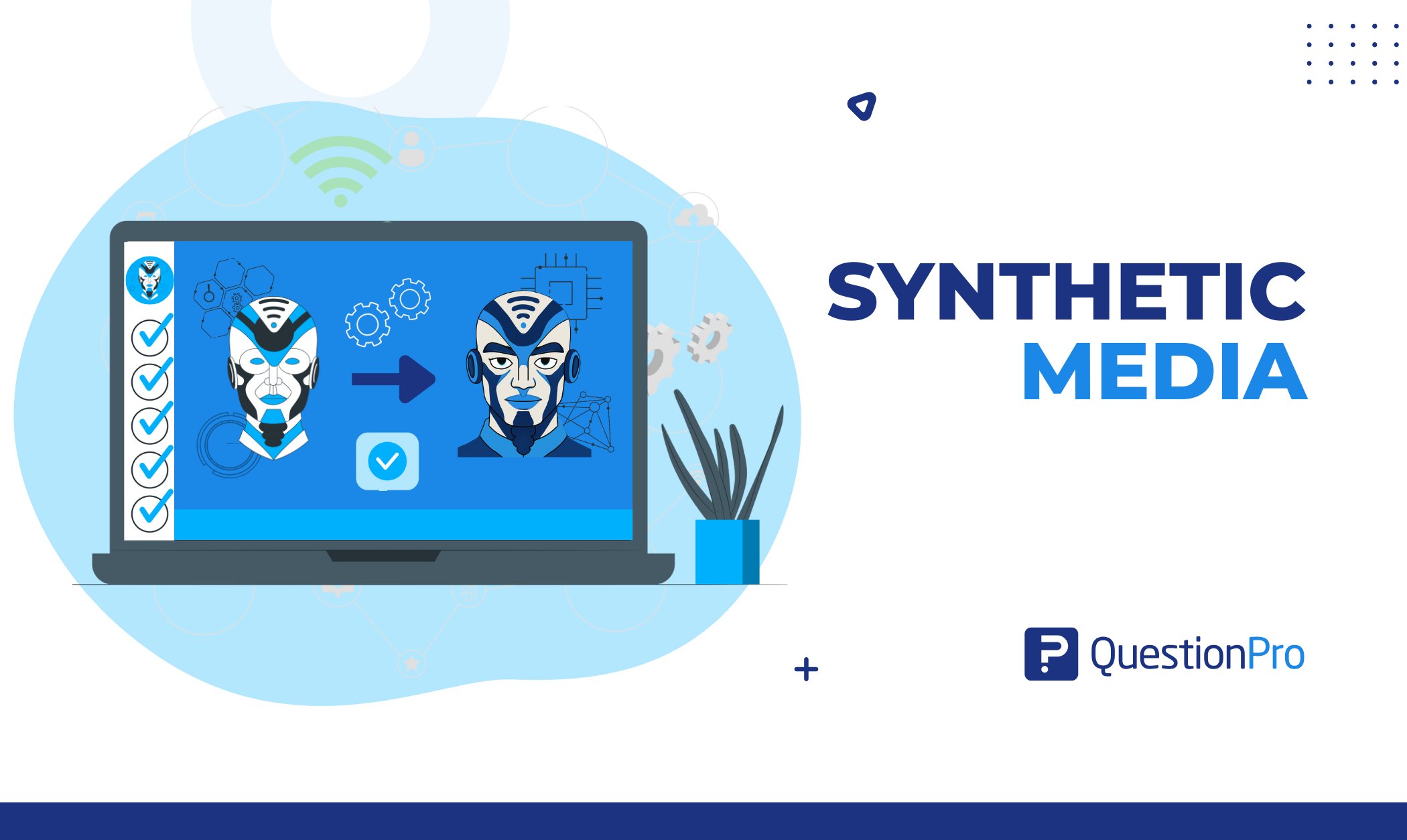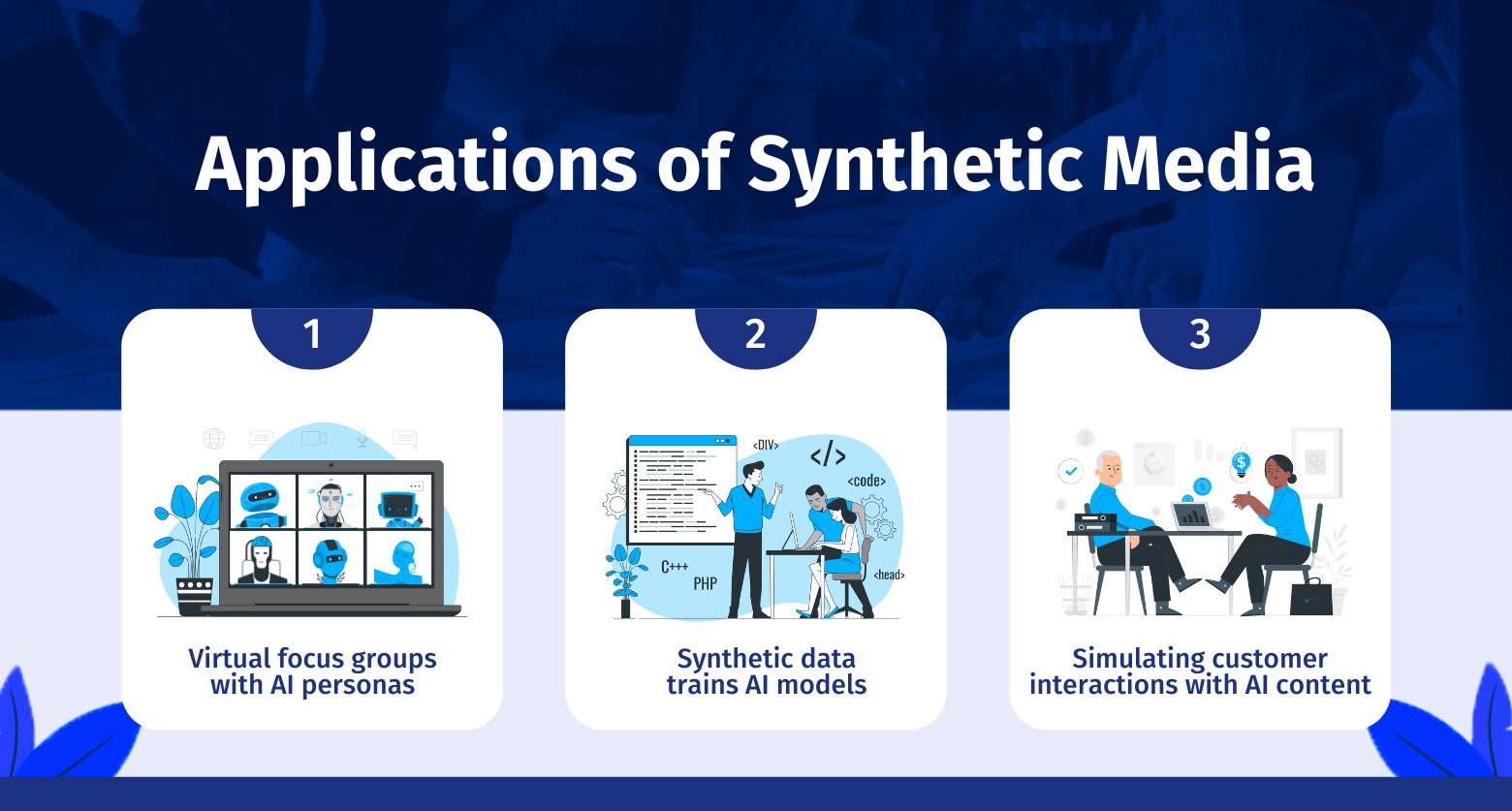
Imagine testing an ad campaign before filming it. Or running a focus group where the participants are AI-generated personas giving realistic feedback. This is no longer science fiction; it’s synthetic media in action.
Synthetic media refers to content created entirely by AI, including text, synthetic images, videos, audio, and even virtual spokespeople. It’s changing how brands prototype ideas, how researchers run tests, and how surveys are conducted. Instead of asking respondents to imagine a concept, you can show them hyper-realistic AI-generated media and gather real-time reactions.
At QuestionPro, synthetic media opens new doors for agile research: testing product videos, simulating customer service interactions, or creating immersive scenario-based surveys.
In this blog, we’ll explore how synthetic media is transforming market research, types, applications, and how you can start using it to enhance your survey and customer experience studies with QuestionPro.
What is Synthetic Media?
Synthetic media is any media content, like videos, images, synthetic data, audio clips, or text, that is artificially generated or significantly altered using artificial intelligence and machine learning. Instead of being captured by a camera, microphone, or written directly by a person, it’s created by powerful AI models.
At its core, synthetic media relies on AI technology like generative adversarial networks (GANs) and stable diffusion models. These generative AI tools analyze vast amounts of raw data to learn patterns and produce new, highly realistic outputs with minimal human involvement.
It allows for incredible creative expression and personalized AI-generated media, but also raises concerns as detection technologies struggle to distinguish it from real footage or recordings, especially when used with malicious intent. Understanding this synthetic content is key to navigating today’s digital channels.
Common Types & Examples of Synthetic Media
Synthetic media comes in many forms, each powered by AI to create content that looks, sounds, or reads like it was made by a human. From images and videos to voice and text, here are the most common types, along with real-world examples of how they’re used.
1. Visual Media Takes the Lead
You’ve seen super-realistic AI-generated images from tools like Stable Diffusion, fantastical scenes from text. Video content like deepfakes swaps faces or manipulates expressions, while fully generated synthetic videos build scenes from scratch.
These visual media types use generative adversarial networks (GANs), with minimal human involvement.
2. Audio, Music & Research Power
Voice cloning technology uses speech synthesis to replicate voices from audio clips, for personalized virtual assistants, but also for scams. AI-written music composes original scores, challenging the idea of human creativity. Crucially, synthetic data powers ethical research.
AI models generate synthetic datasets (such as mimicking medical records or survey responses) to train algorithms without real sensitive raw data. Platforms like QuestionPro utilize this to simulate realistic user feedback for survey testing, eliminating the risk of privacy concerns.
3. Text & Virtual Identities
Generative AI automates content creation through text generation, writing articles or social posts. Virtual influencers, fully artificially generated AI user personas, promote products on social media platforms.
These synthetic media techniques turn data into narratives across many more digital channels, from campaign ads to personalized media.
Whether you’re a platform user, creator, or policymaker, champion transparency, consent, and critical thinking; the future of digital content is in our hands. Stay curious, stay skeptical, and help build trust in the digital age.
Synthetic Media in Research and Marketing
Synthetic media technologies are changing how researchers and marketers create, test, and deliver content. By using AI-generated visuals, text, and simulations, teams can now create high-quality content faster and at scale without the need for expensive production resources.
1. AI-generated survey questions
For your specific demographics or research goals, AI can generate:
- Survey questions
- Visuals
- Audio clips
So you can test and gather feedback at scale for your research.
2. Using synthetic media for product concept testing
Researchers can present hyper-realistic product visuals or videos to respondents, simulating real-life scenarios and capturing more authentic consumer reactions before a product even hits the market.
3. Improving customer experience research with realistic simulations
Virtual environments and synthetic roleplay scenarios allow brands to test customer interactions in real-life situations, to uncover friction points and improve service design.
4. Personalising campaigns with AI-generated content
Researchers can use AI to generate content for individual user segments, including: dynamically
- Ad creatives
- Emails
- Web content
This will improve engagement and conversion rates with minimal effort.
By incorporating synthetic media into research and marketing workflows, you can test faster, personalise at scale, and simulate real-world scenarios with ease.
Applications of Synthetic Media in Survey Research
Synthetic media is opening up new ways to design, test, and refine research. From simulating customer interactions to pre-launch ad testing, these tools help you move faster while getting deeper insights.

Virtual focus groups with AI-generated personas
Create realistic group discussions with synthetic participants to explore reactions and themes before involving real people. Suppose a skincare brand uses AI-generated personas for different age groups and skin types to simulate a focus group discussion on a new anti-aging serum.
Synthetic data trains AI models
Synthetic data creates realistic but fake medical images ethically. Even survey platforms like QuestionPro use it to test tools without real people’s data. Surgeons can practice complex operations in virtual reality simulations before touching a real patient. For people who’ve lost their voice, speech synthesis tech offers a way to communicate again.
Simulating customer interactions with AI-generated content
Recreate realistic customer service scenarios to test scripts, responses, and emotional impact in a controlled, repeatable way. For example, a telecom provider simulates support chats with AI-generated customer personas to test how different service scripts impact satisfaction and loyalty.
These new applications of synthetic media allow you to explore concepts, messaging, and customer interactions in a risk-free environment. By simulating real-world scenarios, you can uncover insights earlier in the process and make smarter decisions and better outcomes.
Benefits of Using Synthetic Media
Synthetic media is a game-changer for researchers and marketers looking to simplify, save, and scale. By integrating AI content into your research workflows, you can unlock new levels of efficiency and consistency.
- Faster content for research scenarios, generate surveys, videos, and visuals in minutes, not days or weeks.
- Cost-effective prototyping of ads, UX designs, and customer journeys, test and refine concepts before investing in full-scale production.
- Scale qualitative research with AI-generated assets, virtual participants, environments, or prompts; no need to recruit loads of people.
- Minimize bias by standardizing stimuli across participants; every respondent sees or hears the exact same thing, resulting in more consistent and reliable results.
Synthetic media is a must-have for modern research and marketing. Whether you need speed, scale, or precision, AI content helps you deliver better outcomes with less overhead.
How QuestionPro Can Use Synthetic Media to Enhance Your Research
Synthetic media can supercharge the survey experience, simulate real-world scenarios, and get richer insights, ethically and efficiently. Here’s how QuestionPro can do it across the platform:
1. Adding AI-generated videos and images to surveys
Enrich surveys with visual stimuli by adding AI-generated product images, explainer videos, or environment mockups. Concept testing, UX studies, and ad feedback become more engaging and realistic without the need for expensive production.
2. Creating immersive concept tests with AI-simulated environments
Recreate realistic settings using synthetic environments like:
- Retail stores.
- Hotel lobbies.
- App interfaces.
These can be embedded into surveys to simulate real user journeys and get more accurate feedback on design, usability, or product appeal.
3. Using synthetic voice or avatars for interactive surveys
Turn traditional surveys into dynamic conversations using synthetic voiceovers or virtual avatars. This can simulate onboarding flows, deliver instructions clearly, or even test customer service scripts in a controlled way.
4. Combining synthetic media with conjoint and MaxDiff analysis
Enhance advanced research methods by combining them with synthetic visuals or narratives.
For example, product features in a conjoint study can be shown through short video demos, or MaxDiff options can be brought to life with engaging visuals to improve understanding and response quality.
QuestionPro’s responsible use of synthetic media gets you more precise research, faster testing, and data privacy intact, all while making surveys more interactive and insightful.
Synthetic Media and Consumer Perception
As synthetic media becomes more part of the research workflow, we need to consider not just what it enables but how it’s received. AI-generated content can change the survey experience, but its impact depends on how participants perceive it.
How people react to AI-generated content in surveys
People may view AI-generated videos, voices, or personas differently depending on context. Some may find them engaging and innovative, others may see them as impersonal or artificial.
Others may feel disconnected, especially if the media feels too artificial, emotionless, or “robotic”. For example, in a product testing survey, respondents may prefer a real spokesperson over a synthetic avatar when evaluating brand authenticity.
Measuring trust, engagement, and realism in synthetic experiences
Researchers can include follow-up questions and behavioral tracking to see how participants react to synthetic media, such as whether they stay longer, skip less, or feel more involved.
For example, A retail brand can use synthetic product demos in a survey and then ask respondents to rate how believable and helpful they found the demo. The feedback can help fine-tune future media use.
We’re not trying to replace human connection but create scalable, realistic experiences that feel personal and trustworthy. By keeping a pulse on perception, QuestionPro users can innovate responsibly and make sure AI-generated content adds clarity, not confusion.
Ethical Considerations of Synthetic Media
As synthetic media becomes more common in research, ethics must keep up.
Using AI-generated content can be more realistic and efficient, but raises questions about transparency, authenticity, and simulated information.
- Transparency in AI-generated content: Participants should know when they’re interacting with synthetic media. Telling them that an avatar, voice, or image is AI-generated helps keep trust and avoid misleading respondents.
- Authenticity in research environments: While synthetic elements can simulate real life, the overall experience must still feel real and genuine. Too many artificial elements can lead to participant fatigue or skepticism.
- Avoiding bias and misinformation: AI-generated content can unintentionally reinforce stereotypes or reflect biases in the training data. Researchers must review synthetic assets carefully to prevent skewed representations or misleading conclusions.
Synthetic media is awesome, but it must be used with integrity. Ethical use means being transparent, keeping participant trust, and staying vigilant against bias or manipulation.
Conclusion
AI can now paint pictures from words, swap faces in videos, clone voices, and write convincing articles. It’s amazing, a little scary, and undeniably here. Through the article, we learn about synthetic media, its potential in research, applications, and the potential dangers associated with its improper use.
Tools like QuestionPro even use synthetic data ethically to protect privacy while advancing research. The potential for good is huge. But the challenges are just as real. How do we trust what we see and hear when deepfakes can spread lies or violate someone’s dignity?
Synthetic media is a powerful tool. Like any tool, its impact depends entirely on the hands that wield it. Let’s choose to use it wisely, ethically, and with a healthy dose of skepticism. The future is in our hands.
FAQs(Frequently Asked Question)
Answer: It can be used to generate survey questions, simulate customer interactions, test product concepts, and even run virtual focus groups, all with AI-generated content.
Answer: Examples include using AI-generated product videos for feedback, synthetic voiceovers to simulate onboarding flows, or avatars explaining questions in an interactive survey.
Answer: By simulating real-life scenarios such as shopping environments or service interactions, synthetic media makes surveys more engaging and helps gather more accurate feedback.
Answer: QuestionPro uses synthetic media to enhance surveys with AI-generated visuals and voices, simulate user environments, and generate synthetic responses to test tools without relying on real participant data.
Answer: Transparency, authenticity, and bias are major concerns. Researchers must disclose the use of AI, avoid reinforcing stereotypes, and ensure experiences remain realistic and trustworthy.







